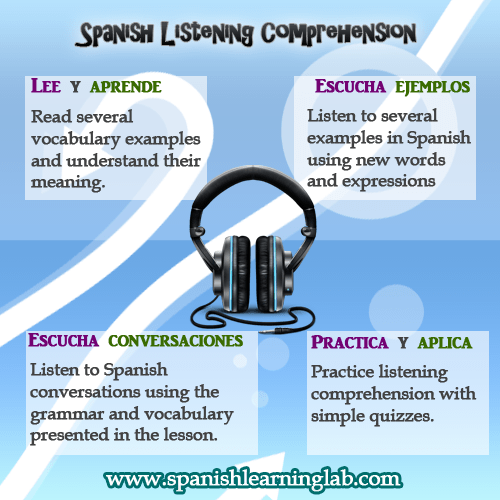Hola and welcome to this guide on how to use the resources in SpanishLearningLab to practice listening and improve this skill along with others. We will give you some tips on how to improve your Spanish listening comprehension by using the resources in our lessons properly. Let’s start…

First, practice Spanish listening with sentences…
Perhaps you have already noticed that we often provide lists of common words for each of the topics, from basic introductions to things like hobbies, eating out or daily routines. We believe that learning just words without context is not enough. That is why you will often see the vocabulary used in sentences or questions, the way native speakers would use them in real situations. To illustrate this, we extracted two examples from one of our lessons on daily activities in Spanish. As you can see, we first introduce the activity (DESPERTARSE) and then use it in a sentence.
|
Despertarse – Yo me despierto al sonar la alarma
To wake up – I wake up when the alarm rings
|
|
Levantarse – Yo me levanto temprano.
To get up – I get up early
|
All these sentences are recorded by Spanish native speakers using a somewhat standard version of the language. The audio can be of great help to practice pronunciation, as well as a warm-up listening activity. Also, sometimes some of these sentences are actually lines of the main conversation in the lesson, and more importantly, they reflect things that you would hear in real life.
Grammar and Spanish listening comprehension
Spanish grammar is really complicated, even for native speakers. However, you can easily learn grammar by focusing on little details about verbs, adjectives and other parts of speech. We think that knowing both the basic structure of sentences and how to use regular and irregular verbs is already a great step for basic Spanish. Most likely, if you do not know what a sentence like “Voy al cine” means when you read it, chances are that you will not be able to understand it in a listening activity. That is the reason why we focus on providing sentences instead of list of words, so that you can practice Spanish listening and also see some basic grammatical structures in use.
Fortunately, every lesson includes simple explanations on the basic grammar you need to understand the examples provided and to create your own. By knowing how the examples work, you can easily understand small variations later in other Spanish listening comprehension activities in the lesson.
Practice listening to Spanish conversations and solving quizzes
Sample conversations
Some of the lessons on the website include lots of sentences focusing on specific words or grammatical structures. Other lessons will not necessarily show a list of sentences, but instead they will provide examples of short Spanish conversations using the vocabulary in real contexts. When we write the sample sentences and conversations, we make sure to include the key vocabulary about the topic. Thus, all the examples provided and the explanations will lead you to easily understand the main Spanish listening activity. Here is an example of a short conversation about colors in Spanish.
- Cliente: Sí, estoy buscando una camiseta talla M.
- Vendedor: ¿De qué color?
- Cliente: Puede ser Azul, Gris o Verde.
- Vendedor: Bien, aquí tiene. Una camisa de color azul. También tenemos en rojo, amarillo y café.
The main Spanish listening activity
The main conversation will often include a couple of new conversational phrases from previous topics and sometimes new expressions you should know about. These phrases are written in a little box just before the audio player. As an example, here is the Spanish listening activity in the daily routines lesson.
Some of the conversations are fast whereas others are slow. However, they do resemble real life conversations and if you cannot understand what you hear, you can always pause or replay using the controls in the audio player. These recordings are often short, less than 1 minute in some cases, so you definitely should spend some time in them. As a last resource, if you cannot understand the recording after trying for some time, you can check the audio script.
Some extra advice on Spanish listening comprehension
We would not recommend you to read the script before attempting to solve the Spanish listening quiz. You wouldn’t be practicing Spanish listening if you read the script first. In order to actually improve your Spanish listening comprehension, or your ability to listen in any other language, you must progressively challenge yourself to listen audio with different speeds and accents. One more last advice, make sure you listen to a recording until you fully understand what is being said, no matter if you have already finished the lesson or solved the exercises your teacher asked you to do.
Learning Spanish, just like learning any other language, requires a lot of work, particularly because there are many accents and ways to say things, so working a little extra will benefit you a lot. We hope you find our website useful for practicing Spanish listening, as this is why this site was created, to provide good quality resources to improve Spanish listening comprehension. Remember, you can leave your comments on each lesson, so we can improve too and give you a better experience.
¡Buena suerte aprendiendo a escuchar en español! ¡Hasta pronto!

Os links de áudio não estão funcionando.